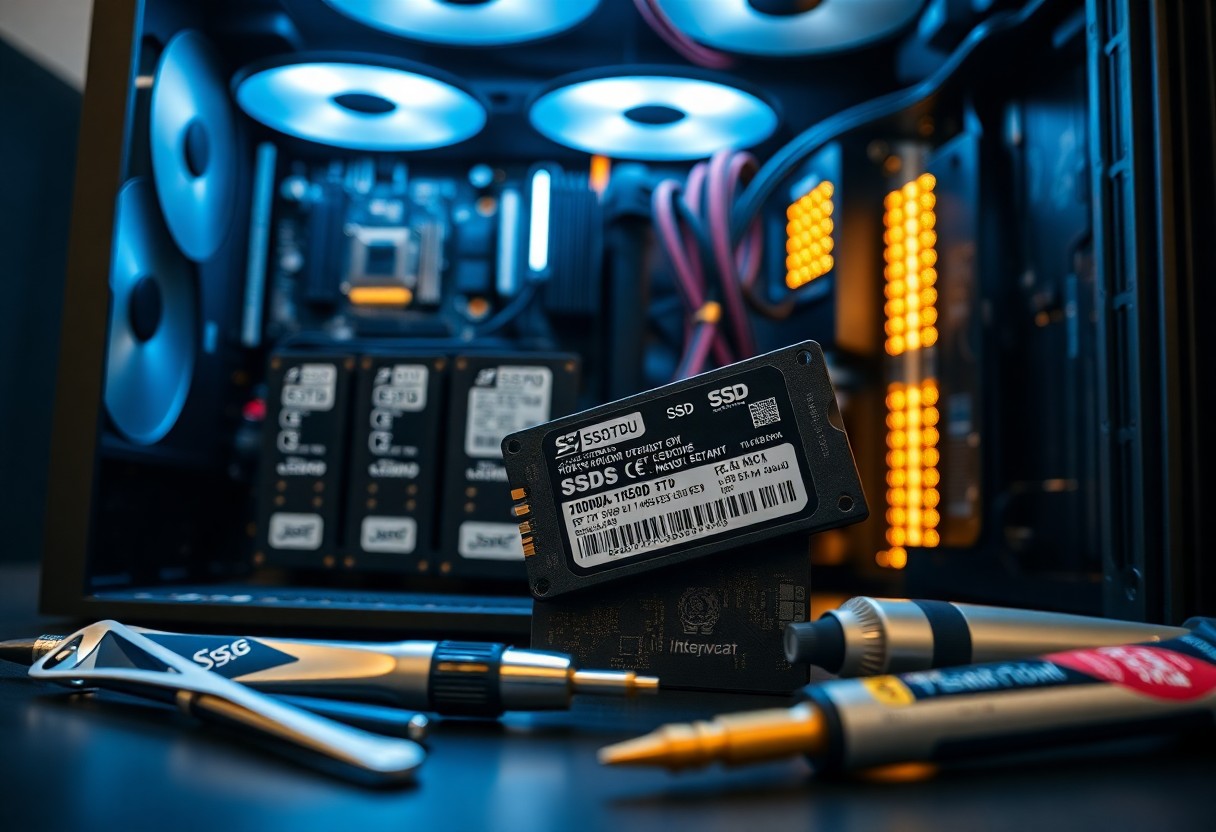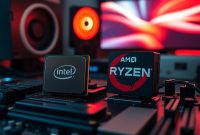Most builders understand that selecting the right SSD can significantly impact your system’s performance and responsiveness. As you explore this comprehensive guide, you will learn about the various types of SSDs, their specifications, and how to determine which one perfectly matches your needs. By the end, you will be equipped with the knowledge to make an informed decision, ensuring your build runs smoothly and efficiently for years to come.
Understanding SSD Types
For a successful build, it’s important to understand the different types of SSDs available on the market. Each type has unique advantages and specifications. Below is a brief overview to help you choose the best option for your needs:
| SSD Type | Key Features |
|---|---|
| SATA SSDs | Affordable, sufficient speed for general use |
| NVMe SSDs | Fast read/write speeds, ideal for professionals |
| M.2 SSDs | Compact form factor, multiple interfaces |
| PCIe SSDs | High bandwidth, excellent performance |
| External SSDs | Portability, easy connectivity |
The right type of SSD can significantly enhance your build’s overall performance.
SATA SSDs
To start, SATA SSDs are the most common and affordable option. They connect via the SATA interface, which offers speed improvements over traditional hard drives but typically has a maximum transfer rate of around 600 MB/s. If your primary use case is general computing or gaming on a budget, a SATA SSD may be a suitable choice, providing substantial performance boosts over HDDs.
NVMe SSDs
There’s a significant leap in performance with NVMe SSDs, which utilize the PCIe interface instead of SATA. This technology is designed for high-speed data transfer, achieving read and write speeds that exceed 3000 MB/s. NVMe SSDs excel in tasks demanding rapid data access and retrieval, making them ideal for gaming, video editing, and heavy multitasking.
It’s important to consider that NVMe SSDs often come at a higher price point due to their cutting-edge technology, but the speed and performance gains may well justify the investment for your more demanding applications.
M.2 and PCIe SSDs
NVMe drives frequently utilize the M.2 form factor, which allows for a compact design and can save space in your build. This compactness is beneficial for laptops and systems with limited room. M.2 drives can function over both SATA and PCIe connections, but for maximum performance, opt for an NVMe M.2 SSD that leverages PCIe technology.
PCIe SSDs stand out for their bandwidth, enabling much faster data transfer than older SATA connections. They can come in various form factors, enhancing versatility in installation. In high-performance setups, you can configure multiple PCIe SSDs to maximize speed and storage capacity, providing impressive throughput for all your demanding tasks.
Key Factors to Consider
The process of selecting the right SSD for your build involves several key factors that can impact your overall performance and user experience. Keep these aspects in mind:
- Storage Capacity
- Speed and Performance
- Endurance and Lifespan
After understanding these factors, you can make an informed decision that suits your needs.
Storage Capacity
If you’re unsure how much storage you need, consider the applications and files you plan to use. Your storage requirements can greatly vary based on whether you’re gaming, video editing, or simply browsing the internet. Aim for a capacity that accommodates your current and future storage needs.
Speed and Performance
The performance of an SSD is primarily defined by its read and write speeds, which dictate how quickly your system can access data. Higher speeds lead to faster boot times and quicker application launches, enhancing your overall user experience.
Storage speed is influenced by several factors including the interface type, with NVMe drives typically outperforming SATA drives. Additionally, higher IOPS (Input/Output Operations Per Second) ratings can provide significant advantages in workloads requiring rapid data access, such as gaming or file transfers. Understanding these specifications enables you to select an SSD that will meet your performance expectations.
Endurance and Lifespan
Clearly, the endurance and lifespan of an SSD are vital considerations in your purchase. These factors determine how long your drive will last under regular use and how well it can handle intensive tasks.
To evaluate endurance, look for the drive’s TBW (Terabytes Written) rating, which indicates how much data can be written to the drive before its reliability decreases. Drives with higher TBW ratings are generally suited for heavier workloads. Additionally, technologies like TRIM help maintain drive performance over time, ensuring that your SSD stays efficient for years to come.
Pros and Cons of Each Type
Keep in mind that each SSD type has its own set of advantages and drawbacks. Understanding these can help you make an informed decision for your build. Below is a breakdown of the pros and cons of various SSD types.
| Type | Pros |
|---|---|
| SATA SSD | Affordable, widely compatible, decent performance. |
| NVMe SSD | High speed, lower latency, efficient, great for gaming. |
| M.2 SSD | Compact design, easy installation, high performance. |
| External SSD | Portability, easy to use, can expand storage capacity. |
| Enterprise SSD | Durable, designed for heavy workloads, high reliability. |
| PCIe SSD | Fast transfer speeds, multiple lanes for better efficiency. |
| Hybrid SSD | Cost-effective, combines SSD speed with HDD capacity. |
| MLC SSD | Better endurance, improved performance over TLC. |
| TLC SSD | Affordable, good performance for daily tasks. |
| QLC SSD | High capacity at a lower price, suitable for storage needs. |
Advantages of SSDs
Advantages of SSDs include faster boot times, quicker file transfers, and improved overall performance compared to traditional hard drives. They are more reliable as they have no moving parts, which makes them less susceptible to mechanical failures. Additionally, SSDs use less power, resulting in longer battery life for laptops and portable devices.
Disadvantages of SSDs
Disadvantages include higher cost per gigabyte compared to HDDs and limited write cycles for certain types.
This can lead to concerns about longevity and endurance, particularly for heavy users who perform read/write-intensive tasks. Additionally, while SSD prices have been decreasing, larger capacities still tend to be relatively expensive. Some SSDs may also have slower speeds when used as secondary storage. Be sure to evaluate your specific needs and budget before making a choice.
Tips for Selecting the Best SSD
To ensure you pick the right SSD for your needs, consider the following tips:
- Determine your storage capacity requirements.
- Choose between SATA, NVMe, or M.2 based on speed needs.
- Look for reliability and warranty support.
- Check read/write speeds to match your performance expectations.
- Evaluate heatsink or cooling options if you plan to overclock.
Knowing how each factor impacts performance will empower you to make a well-informed decision.
Matching SSD to Use Case
To find the best SSD for your use case, identify what tasks you’ll be performing. For gaming, opt for high-speed NVMe drives that minimize load times. For content creation or data-heavy applications, prioritize storage capacity and speed. Meanwhile, casual users who primarily browse or stream can choose more affordable SATA options. Understanding your primary use will guide you toward the SSD type that strikes the best balance between performance and cost.
Setting a Budget
Setting a budget is important to narrowing down your SSD options without overspending. Clearly define how much you are willing to invest in storage based on your needs. Consider the price-per-gigabyte ratio, as it can vary significantly between SSD types. This way, you can weigh your options while ensuring you get the best value for your desired performance.
Matching your budget to your storage needs involves assessing both short-term costs and long-term benefits. High-performance NVMe drives typically cost more upfront but can improve productivity and system responsiveness. On the other hand, SATA SSDs come at a lower price point but may offer slower speeds. Evaluating your priorities—whether they lean towards fast performance or economical storage—will help you select the ideal SSD without straining your finances.

The Step-by-Step Guide to Installing an SSD
Your SSD installation journey can be seamless if you follow these steps diligently. Whether you’re upgrading or building a new PC, understanding the process will help ensure success. Below is a simple guide to make your SSD installation straightforward.
| Step | Action |
| 1 | Preparation |
| 2 | Installation Process |
| 3 | Configuration |
Preparation
Preparation is key to a successful SSD installation. First, gather your tools, including a screwdriver, and ensure you have your SSD and necessary cables ready. Make sure to back up your data, and power off your device completely before you proceed.
Installation Process
Installation involves physically securing the SSD in your computer or laptop. Open the case, locate the appropriate slot for the SSD, and connect the data and power cables. Align the SSD and fit it into place, ensuring a snug connection for optimal performance.
Another important aspect of the installation process is to check that your SSD is properly seated in the designated slot. Each type of SSD has specific mounting requirements—whether it’s a 2.5-inch SATA or an M.2 NVMe SSD. Use the appropriate screws or brackets as needed to secure it firmly in place.
Configuration
Installing the SSD is just the beginning; configuring it is equally important. Boot up your device and access your BIOS/UEFI settings to ensure the SSD is recognized. You may also need to format the drive through your operating system for it to be usable.
Guide yourself through the setup by following the on-screen prompts. Depending on your system, you might want to partition the SSD for different uses. Ensuring the SSD is set as the primary boot device can help you take full advantage of its speed and capacity.
Conclusion
Upon reflecting on the various factors involved in selecting the right SSD for your build, it’s clear that understanding your specific needs—such as storage capacity, speed, and budget—plays a significant role in making an informed decision. By considering these elements and using the insights provided in this guide, you can confidently choose an SSD that enhances your system’s performance and meets your requirements. With the right SSD, you can ensure your build runs efficiently and effectively, allowing you to get the most out of your technology.



